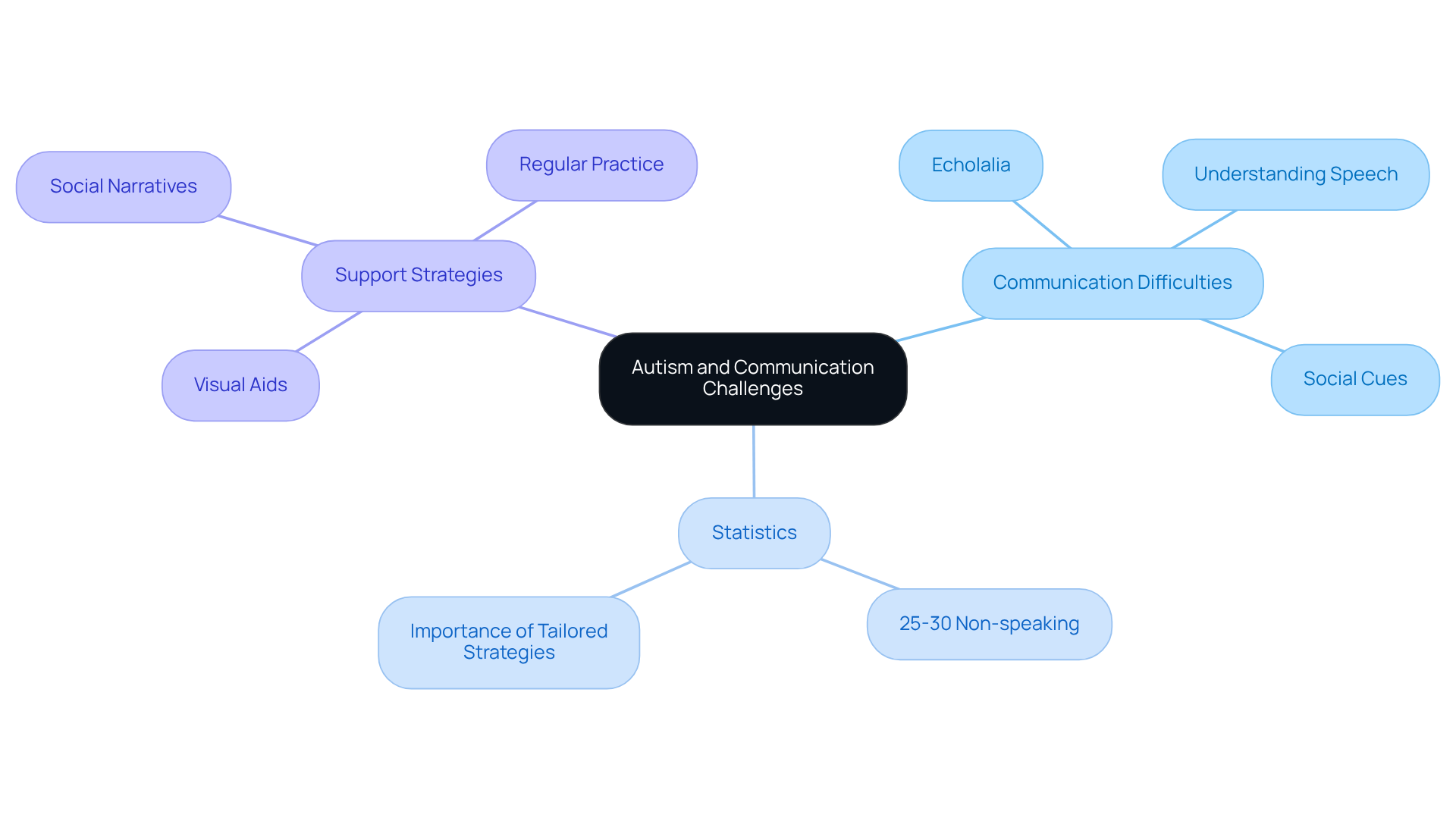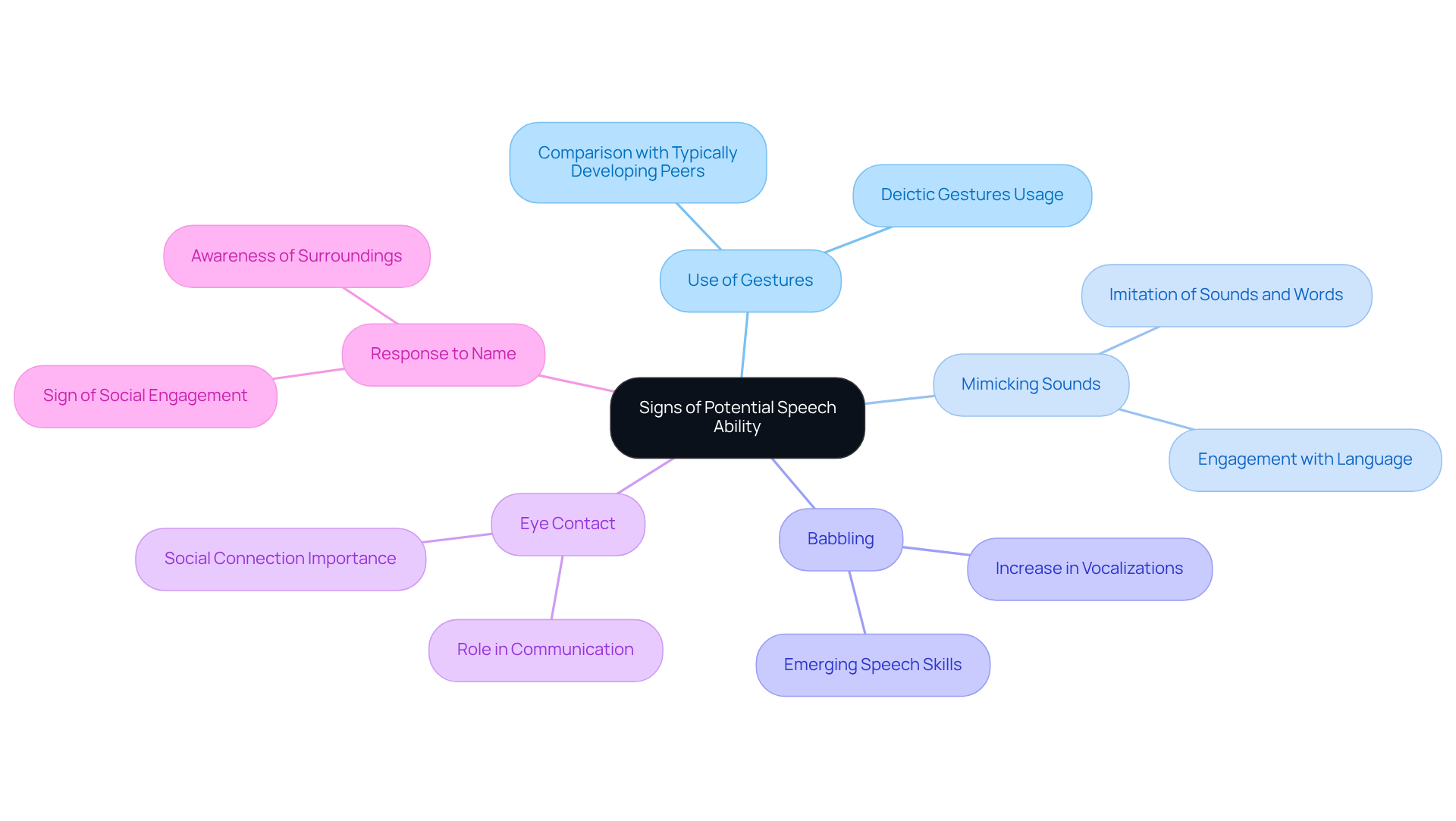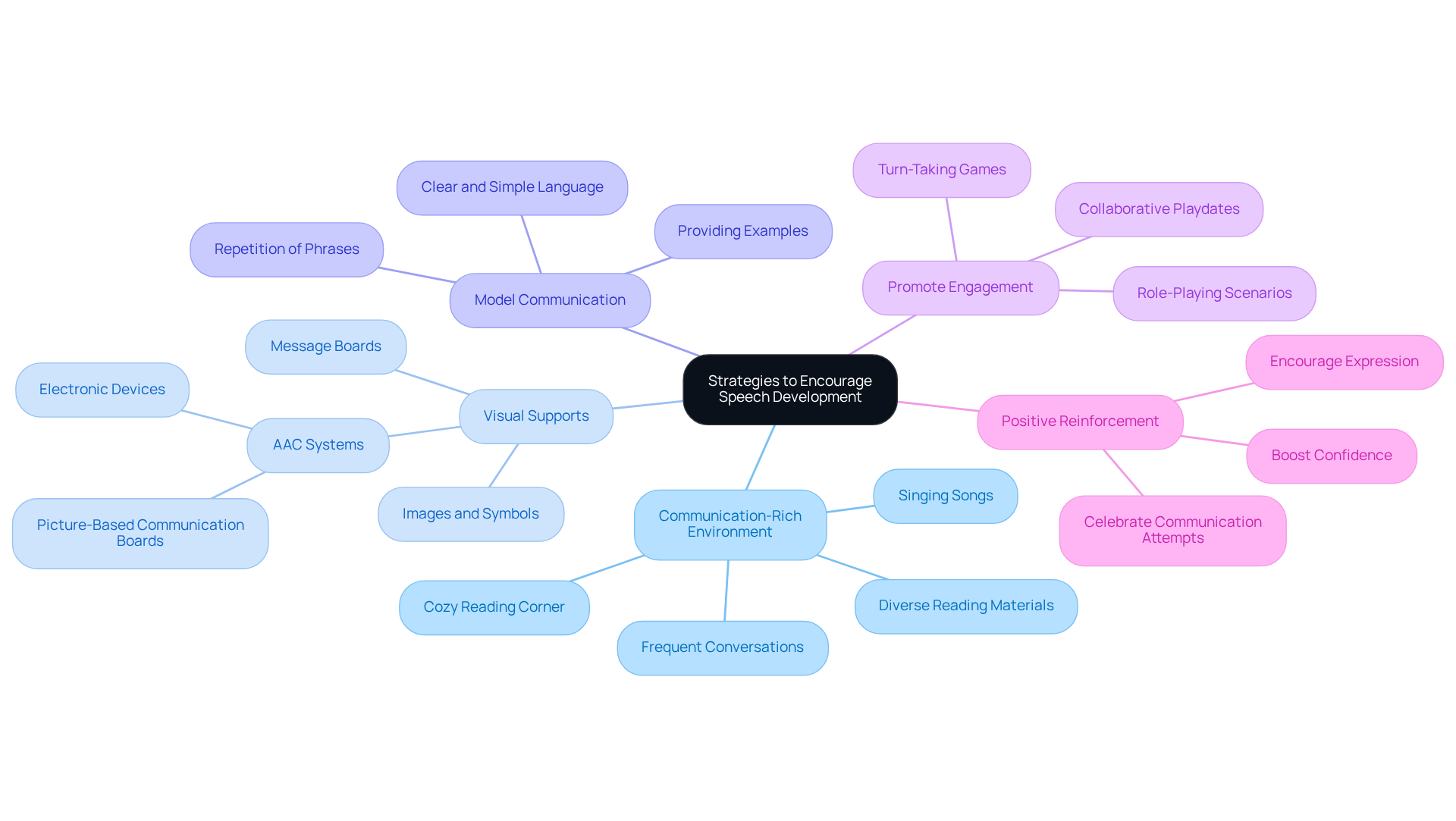Overview
This article highlights the crucial process of assessing whether your autistic child can communicate effectively. By observing specific behaviors, such as gestures and vocalizations, you can gain valuable insights into their potential speech abilities. Recognizing these signs is the first step toward fostering effective communication skills.
Imagine the joy of seeing your child express themselves more clearly. Tailored interventions can make a significant difference. Consulting with speech-language pathologists can provide expert guidance, while creating a communication-rich environment at home encourages your child to engage and interact more freely.
As you navigate this journey, remember that you are not alone. Many parents face similar challenges, and sharing experiences can offer comfort and support. Consider reaching out to professionals who can assist you in this process, ensuring your child has the best opportunities to thrive in their communication skills.
Take action today by exploring resources that can help you and your child on this path. Together, we can nurture their potential and celebrate every step forward.
Introduction
Understanding the complexities of communication in children with Autism Spectrum Disorder (ASD) is essential for parents embarking on this unique journey. It’s crucial to recognize specific behaviors and implement effective strategies that support speech development. Yet, with numerous challenges and uncertainties, how can parents accurately assess their child's communication potential? This article explores critical steps that can illuminate the path toward enhanced expressive abilities. We aim to offer insights and practical approaches to support children in their communication journey, fostering a deeper understanding and connection.
Understand Autism and Communication Challenges
Autism Spectrum Disorder (ASD) profoundly impacts interactions, presenting various challenges that parents must navigate with care. Children with autism often face hurdles in both verbal and non-verbal communication, which can manifest as difficulties in understanding speech, using gestures, and engaging in conversations. One notable phenomenon is echolalia, where children may repeat phrases or sentences they have heard instead of using language functionally. While this behavior can serve as a coping mechanism or a way to process communication, it may also hinder effective interaction.
Moreover, many individuals with autism struggle to grasp social cues, such as vocal tone or nonverbal communication, which complicates their interactions with peers and adults. For example, a young person might not recognize when someone is joking or may misinterpret a friendly gesture as threatening. Understanding these interaction difficulties is crucial for assessing whether your child can autistic child speak normally and for developing strategies to support their communicative growth.
Statistics indicate that approximately 25-30% of children with developmental disorders are non-speaking or minimally verbal, underscoring the importance of tailored communication strategies. As emphasized by speech-language pathologists, fostering an environment that encourages interaction through visual aids, social narratives, and regular practice can significantly enhance a child's ability to express themselves and connect with others.
Prominent figures in the autism community, such as Temple Grandin, remind us that individuals with autism are 'different, not less.' This perspective highlights the essential need for understanding and support in their communication journeys. If you have experiences or insights to share, consider joining the conversation in the comments or through our newsletter, as together we can create a more inclusive world for our children.

Identify Signs of Potential Speech Ability
As a loving parent, you may wonder whether your autistic child can speak normally. A thoughtful approach begins with observing their expressive behaviors closely. Here are some key indicators to consider:
- Use of Gestures: Are they using gestures like pointing or waving to express themselves? Research indicates that children with ASD often use deictic gestures less frequently than their typically developing peers, which can signal early challenges in interaction.
- Mimicking Sounds: Do they imitate sounds or words they hear from others? This behavior is vital as it showcases their engagement with language.
- Babbling: Is there an increase in babbling or vocalizations? More vocalization may suggest emerging speech skills.
- Eye Contact: Are they making eye contact during conversations? Eye contact plays a significant role in effective communication and social connection.
- Response to Name: Do they respond when you call their name? This responsiveness is an essential sign of social engagement and awareness.
These behaviors are important as they indicate if a child with autism can speak normally and develop the foundational skills needed for speech. By observing these indicators over time, you can gain valuable insights into your child's verbal expression and potential for further communication. As Wetherby et al. noted, understanding interaction patterns and their relation to developmental outcomes emphasizes the importance of gesture development in evaluating young individuals' communication.
Remember, you're not alone in this journey. Sharing your experiences and seeking support can make a significant difference.

Implement Strategies to Encourage Speech Development
To nurture your child's speech development, consider these heartfelt strategies:
- Create a Communication-Rich Environment: Surround your child with language by engaging in frequent conversations, reading a variety of books, and singing songs. This exposure allows them to absorb communication naturally. For instance, designing a cozy reading corner filled with diverse books can inspire your little one to explore language in a comfortable setting.
- Utilize Visual Supports: Incorporate visual aids like images, symbols, or message boards to assist your child in understanding and expressing their needs. Research indicates that these aids can significantly enhance interaction abilities, particularly for individuals with autism. A 2021 study revealed that AAC systems promote and improve communication for autistic individuals.
- Model Communication: When interacting with your child, use clear and simple language. Repeating phrases and providing examples can reinforce their learning and comprehension. Speech therapists often emphasize the importance of demonstrating communication to help children grasp new vocabulary and sentence structures.
- Promote Engagement: Involve your child in activities that encourage dialogue, such as turn-taking games or role-playing scenarios. These interactions can motivate them to practice their language skills in a fun and supportive environment. For example, organizing a playdate where kids can engage in collaborative games can foster social interaction.
- Positive Reinforcement: Celebrate every attempt at communication, whether verbal or non-verbal. Acknowledging their efforts boosts their confidence and encourages them to express themselves more freely. As speech therapists highlight, positive reinforcement is crucial in motivating children to communicate.
These strategies not only build your child's confidence but also enhance their ability to use language effectively, paving the way for improved communication skills.

Navigate Challenges and Seek Support Resources
Supporting your child's speech development can lead to the question of whether an autistic child can speak normally, which presents various challenges that many parents face. However, there are effective strategies to help determine if an autistic child can speak normally and navigate these obstacles with confidence and care.
- Consult Speech-Language Pathologists: Engaging with speech-language pathologists (SLPs) who specialize in autism is crucial. They can evaluate your child's communication skills and develop a tailored intervention strategy that meets specific needs. Research shows that early intervention greatly enhances outcomes for children with developmental disorders, which leads to the question of whether an autistic child can speak normally. Remember, early exposure to language is vital for understanding if an autistic child can speak normally, ideally before school age.
- Join Parent Support Groups: Connecting with other parents through local or online support groups can provide invaluable insights and shared experiences. Many families participating in support groups report increased emotional well-being and enhanced coping strategies, fostering a comforting sense of community.
- Leverage Online Resources: Utilize dedicated websites and forums focused on support for individuals with developmental disorders, such as Autism Speaks or the National Autistic Society. These platforms offer a wealth of information and community connections that can aid you on this journey.
- Stay Updated on Research: Keeping abreast of the latest findings and strategies in autism communication is essential. This knowledge empowers you to adapt your approach effectively, ensuring that you are using the most current and effective methods. Did you know that about 5% of U.S. youths aged 3-17 experience a speech disorder lasting a week or more in the past year? This statistic emphasizes the significance of obtaining professional assistance.
By actively seeking professional guidance and community support, you can create a nurturing environment that addresses whether an autistic child can speak normally. Remember, you are not alone in this journey, and there are resources and people ready to support you.

Conclusion
Understanding the communication landscape for children with Autism Spectrum Disorder (ASD) is vital for parents who wish to foster their child's expressive abilities. Recognizing the unique challenges these children face and implementing targeted strategies allows parents to effectively support their journey toward speech development. This nuanced approach not only empowers children but also strengthens the bond between parent and child, creating a nurturing environment for growth.
Key insights include the importance of observing specific behaviors that indicate speech potential, such as:
- The use of gestures
- Responsiveness
- Eye contact
By creating a communication-rich environment, utilizing visual aids, and promoting engagement, parents can significantly enhance their child's ability to communicate. Additionally, seeking professional guidance from speech-language pathologists and connecting with support networks can provide invaluable resources and encouragement for parents navigating this journey.
Ultimately, assessing and supporting an autistic child's speech development requires patience, understanding, and community support. By actively engaging in this process and utilizing available resources, parents can play a pivotal role in their child's communication success. Embracing this journey not only benefits the child but also fosters a more inclusive society that values diverse communication styles.
Frequently Asked Questions
What is Autism Spectrum Disorder (ASD) and how does it affect communication?
Autism Spectrum Disorder (ASD) significantly impacts interactions, leading to challenges in both verbal and non-verbal communication. Children with autism may struggle to understand speech, use gestures, and engage in conversations.
What is echolalia and how does it relate to communication in children with autism?
Echolalia is a phenomenon where children with autism repeat phrases or sentences they have heard instead of using language functionally. While it can serve as a coping mechanism or a way to process communication, it may also hinder effective interaction.
What social cues do individuals with autism often struggle to understand?
Many individuals with autism have difficulty grasping social cues, such as vocal tone and nonverbal communication. This can lead to misinterpretations, such as not recognizing when someone is joking or perceiving a friendly gesture as threatening.
What percentage of children with developmental disorders are non-speaking or minimally verbal?
Statistics indicate that approximately 25-30% of children with developmental disorders are non-speaking or minimally verbal, highlighting the need for tailored communication strategies.
What strategies can help improve communication for children with autism?
To enhance communication, it is important to create an environment that encourages interaction using visual aids, social narratives, and regular practice, as recommended by speech-language pathologists.
What message does Temple Grandin convey about individuals with autism?
Temple Grandin emphasizes that individuals with autism are 'different, not less,' underscoring the importance of understanding and support in their communication journeys.




